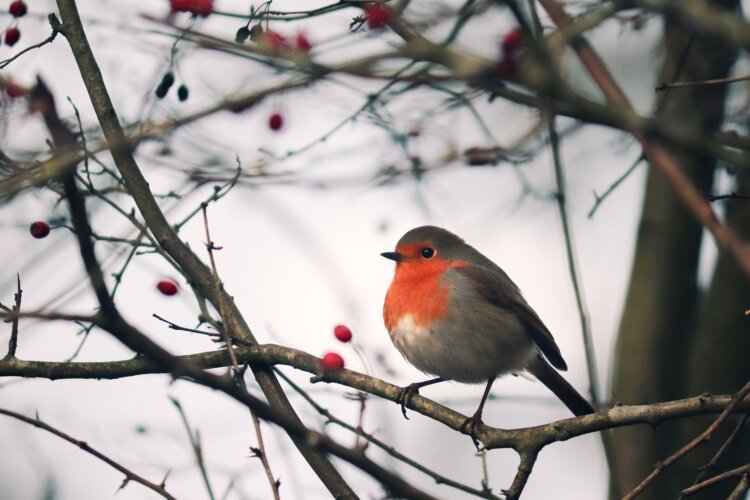
Whether you call it a polar vortex, snowpocalypse or snowmageddon, as temperatures plummet and snow piles up, life gets a little rough for the birds in your neighborhood. Data shows that birds benefit from our attention, and some species have a greater overall chance of winter survival—and are healthier—with access to supplemental food from the millions of people who stock feeders. Emma Grieg, the program manager for Project FeederWatch, assured me that birds could survive without us, but on the harshest days, they get a boost from our efforts.
Project FeederWatch is a citizen science data gathering program that has been running for 32 years in the U.S. and Canada, and includes 20,000 people recording their observations of backyard birds this year. Because the program uses scientific protocols, the data is statistically relevant and has revealed shifts in species’ geographical regions, immigration patterns and health. To sign up as a volunteer bird feeder watcher, you’ll need to pay $18 to register and receive an ID number and a packet of detailed information about identifying birds and recording your sightings. If you’re one of the 40 percent of Americans who feed birds, your contributions matter.
In fact, you can start this weekend with a global effort from the Audubon Society! From Feb. 15 to 18, they’re inviting people to take part in the Great Backyard Bird Count. No experience is necessary and as little as 15 minutes makes a difference. Learn a little about birds through Audubon’s checklist and contribute to a worldwide event. Last year more than 160,000 people helped.
Sparrows, doves, chickadees, and finches—all called generalist birds—are hanging in there, living in close contact with us throughout the colder months. Grieg said, “The concerns are the smallest for birds that visit feeders. They seem to be faring well.” Specialist birds that need a specific set of conditions—nesting areas and material, insect diets, less disturbance, for example—aren’t as okay. Of more than 1,000 native bird species in the U.S., 30 percent have serious threats to their longtime survival.
Climate change is only one of the many pressures. What was once a thriving ecosystem for birds is now a home owner’s landscaped yard, parking lot or sidewalk. While bird feeders might fill some of the gap created by lost habitat, only species that are adapted to living around humans and seed/grain/nut eating birds that are supported.
There isn’t a lot of research about why we feed birds, but once you start, you probably won’t stop. Where I live, feeders attract bears and people are so dedicated to their birds, they refuse to take down the seed containers even though a large, powerful, wild animal has come for their black oil sunflower seed and suet cakes.
If you’re going to help feed birds, here are some guidelines to keep in mind for birds’ wellbeing:
Safety first! It may seem like it doesn’t need to be said, but keep your cats indoors. Cats are the single biggest cause of bird deaths. Let kitty watch safely from a window.
Position feeders so that birds don’t crash into windows, which can injure or kill them. Grieg said that closer is better than far away because they don’t have much speed if they hit.
Clean feeders regularly. One of the biggest concerns about feeders is spreading disease. If a sick bird shares a perch with healthy birds, viruses can be transmitted. Best practices are to take down your feeder if you notice sick birds. Grieg said the signs of illness are seeming sleepy or slow, squinty or closed eyes, puffed up feathers. Obvious inflammation around the eye could be conjunctivitis, pink eye for birds.
Project FeederWatch recommends using soap and warm water to wash the feeder and rinsing well to remove any residue. Or use a diluted bleach solution that will evaporate when it dries. Offer fresh food, nothing dusty or moldy. Black oil sunflower seed and thistle have high fat content that helps birds in harsh conditions.
No feeder? No problem! If keeping a feeder in your yard isn’t feasible, a birdbath is another way to enjoy watching birds. Any bird will visit it, and you can keep it filled year round without the concerns of attracting other wildlife.
Enlist your garden’s help. Planting native species of perennials, berry and nut producing woody plants, and leaving space for some wildness in your yard supports birds, too. A high-impact perennial garden could include milkweed, thistle (finches love it), asters and goldenrods. Native willows, found in many regions, are a beautiful and easy fix that provide food and shelter for more than 400 species of insects and birds.


Grok Nation Comment Policy
We welcome thoughtful, grokky comments—keep your negativity and spam to yourself. Please read our Comment Policy before commenting.